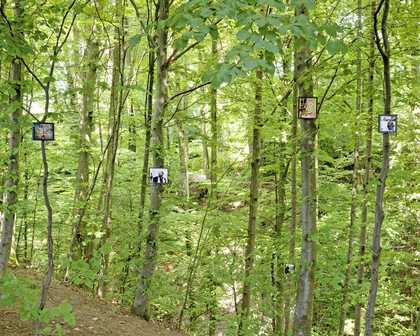
Geoffrey Farmer
If You Want To See Something Look at Something Else (Allen Ginsberg 1926-1997) from The Invisible Worm that Flies in the Night, 2011
50 colour photographs mounted on perspex, framed
Installation dimensions variable
Photo credit: Catriona Jeffries Gallery
Who is he?
Geoffrey Farmer is a Canadian artist, based in Vancouver. His career as an artist was not planned, he simply attended an art class with his sister when he was 21 and that was that.
Farmer’s work is multi-media, using collage, photography, drawing, sculpture, video and many found materials to create complex pieces which can contain sound or mechanical elements to bring them to life.
Farmer is known to drastically edit and rearrange his pieces according to the space in which they are installed. Curator Jessica Morgan jokingly labelled him the ‘enemy of the museum’ because of his tendency to change a piece throughout an exhibition.
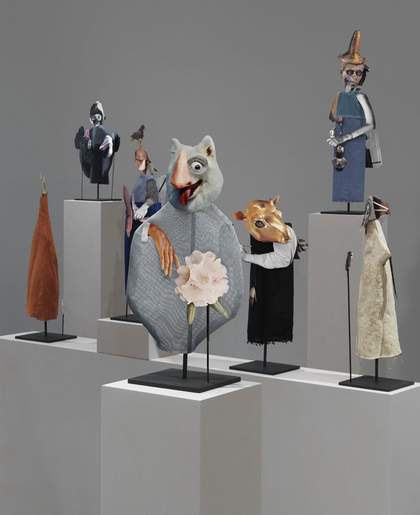
Geoffrey Farmer
The Surgeon and the Photographer, 2009
365 puppet figures, fabric, found images, metal stands, 60 wooden plinths
Installation dimensions variable
Photo credit: Catriona Jeffries Gallery
How does he choose his titles?
There is a story about the library of the Warburg Institute… in the 1920a, that when you asked for a book, they would give it to you, but they would also give you three or four others that were considered friends of your book. To me, this expresses a kind of… thinking that feels similar to my process of conjuring up a title…. I look for a title that creates the right atmospheric conditions to create an electricity to spark the engine of the work. I sometimes describe it as the sound of an engine starting. That is when I know it’s the right title.
Geoffrey Farmer interview with Amy Luo, Canadian Art Magazine, 2015
What are his key works?

Geoffrey Farmer
The Last Two Million Years, 2007
Foamcore plinths, perspex frames and cutouts from selected pages of the history-book The Last Two Million Years
Installation dimensions variable
Photo credit: Catriona Jeffries Gallery
The Last Two Million Years is a piece inspired by a found encyclopaedia of the same name. Farmer was impressed by the book’s’ bold attempt to encapsulate the entire history of the world.
Using its pages, Farmer created his own paper sculptures, including some of vikings and Queen Elizabeth, randomly assorted on plinths. The passing of time is disregarded, so we have to readjust our chronological thinking and see all of existence, amassed in front of us. The titles accompany the piece in a small booklet and many are extracts from the original encyclopaedia. The Gandhi cut-out is accompanied by the extract:
When I despair, I remember that all through history the way of truth and love has always won. There have been tyrants and murderers, and for a time they seem invincible, but in the end they always fall – think of it, always’ and so we are asked to recall the rise and fall of man throughout time.

Geoffrey Farmer
Exhibition view, Let's Make The Water Turn Black, Migros Museum fur Gegenwartskunst. 2013
Photo credit: Catriona Jeffries Gallery
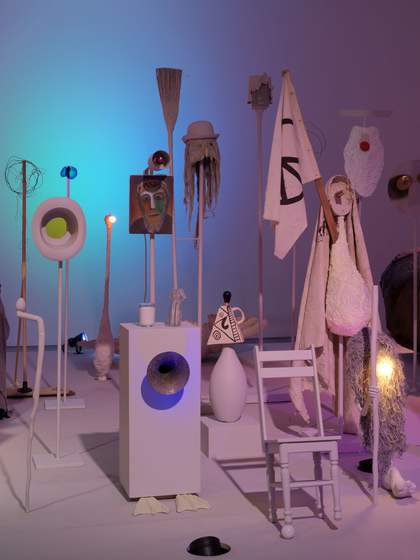
Geoffrey Farmer
Exhibition view, Let's Make The Water Turn Black, Migros Museum fur Gegenwartskunst. 2013
Photo credit: Catriona Jeffries Gallery
Farmer’s ever-evolving work Let’s Make the Water Turn Black is a tribute to Frank Zappa’s 1968 composition. Farmer uses elements of sound from Zappa’s entire career, including clips of popular songs, radio broadcasts, musical instruments and other sound effects. The piece itself becomes the instrument; with over 70 bizarre abstract objects, salvaged movie props and assorted materials, animated by a computer to produce noises or set things a-jingling. The theatrical lights continuously change, altering the atmosphere of the room. Farmer’s collage aesthetic mimics that of Zappa’s music, so that the sense of time passing as the piece continuously moves and evolves mirrors the literal recording of time passing as Zappa’s life is played out in the listener’s ears.
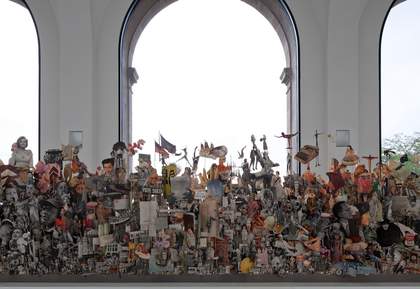
Geoffrey Farmer
Leaves of Grass, 2012
LIFE Magazines (1935-85), tall grass, wood, glue
Installation dimensions variable
Photo credit: Catriona Jeffries Gallery
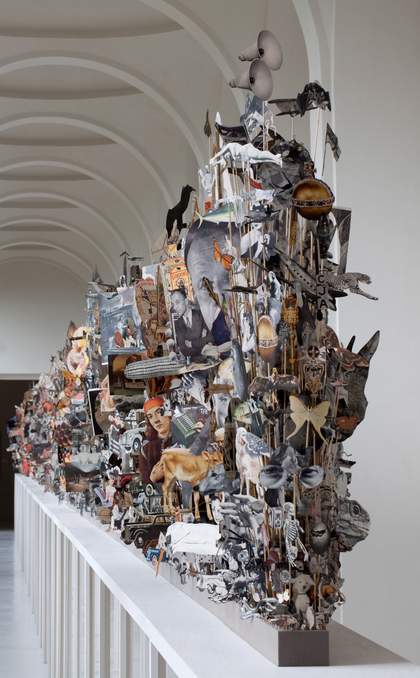
Geoffrey Farmer
Leaves of Grass, 2012
LIFE Magazines (1935-85), tall grass, wood, glue
Installation dimensions variable
Photo credit: Catriona Jeffries Gallery
Another of Farmer’s pieces was named after Walt Whitman’s life-long project, the poetry book Leaves of Grass. Whitman would often cut up his writing to create the poems, which were to be a portrait of the United States. Farmer, similarly uses collage to create a portrait of mankind. The work is an epic, sculptural photomontage; 16,000 figures made from 900 issues of Life Magazine spanning from 1935 to 1985, chronologically ordered and mounted onto dried grass sticks:
I knew from the beginning that it was important the figures be placed in chronological order… It hadn’t occurred to me that it would be a strange kind of history lesson. It was like a slow-motion flip-book
Interview with Rosemary Heather, Canadian Art, 2012
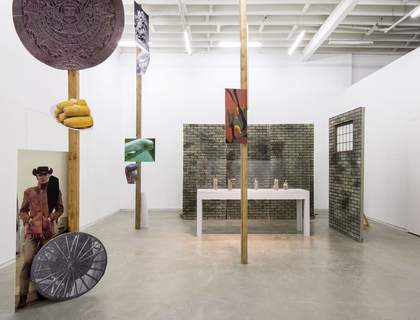
Geoffrey Farmer
Installation view, The Grass and the Banana go for a walk, 2013, Catriona Jeffries, Vancouver
Photo credit: Catriona Jeffries Gallery
What do the critics say?
Geoffrey Farmer makes us question what we expect of art in the first place.
Kim Dhillon, Freize
Spanning the figurative to the fantastic, the ‘indigenous’ to the ‘modern’, Farmer’s sculptures wear their influences without apology
Terry R. Myers, Art Review
The It Guy of Canadian contemporary art.
Marsha Lederman, The Globe and Mail
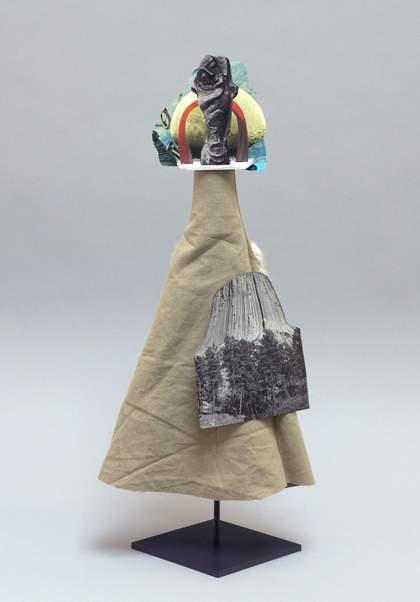
Geoffrey Farmer
The Surgeon and the Photographer, 2009
365 puppet figures, fabric, found images, metal stands, 60 wooden plinths
Installation dimensions variable
Photo credit: Catriona Jeffries Gallery
Farmer in quotes…
I don’t think up a concept and then execute it. I learn through discovery and from direct contact with the material I am using.
Interview with Rosemary Heather, Canadian Art, 2012
My work really comes out of an engagement with a place. I really want the work to feel like it’s grown out of the [space]—that it hasn’t been plunked there.
Interview with David Balzer, Canadian Art, 2015
The work is work, which is to say, a process… I like the possibility of rearrangement, reassessment, another chance.
Interview with Sky Godden, BLOUIN ARTINFO, 2012
